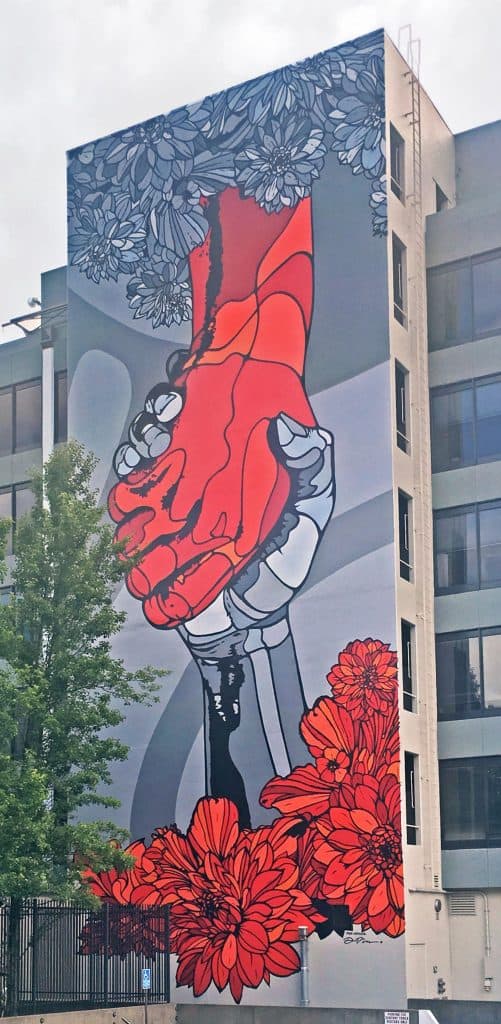by Mario Mesquita, Manager of Advocacy and Engagement

David Flores’ large outdoor mural, Helping Hand, located on the Century Building in downtown Portland, 1201 SW 12th Ave. The mural faces Outside In directly and can be seen clearly from the I-405 freeway. Mural supported by RACC.
Saludos, Greetings, and Hello fellow community members, supporters, artists, artist folx, and friends of the Regional Arts & Culture Council.
Hands outstretched in an embrace with one another. One hand reaching for the other, both springing from different colored bouquets, one red, one grey. Located at Southwest 12th Avenue in Portland, David Flores’ mural, Helping Hand, embodies what the past year and a half have been for many of us. As the artist himself put it: [it’s about] “…people helping people. Help a worn and weary [person]. Neighbors helping friends. Families helping families….This is what life is all about.”
It has now been a little more than eight months since I’ve taken the role of the newly developed position of Manager of Advocacy and Engagement at RACC and have had the pleasure of getting familiar with the region’s thriving creative community, and the fundamental contributions of Black, Indigenous, and People of Color to Oregon’s arts and cultural sector. I was excited to return to Oregon after more than a handful of years of working and attending school in southern California. In particular, I was enthusiastic about joining an arts organization that valued accessibility, advocacy, equity, diversity, community, and innovation of the arts and culture for everyone.
I bring to the role experience from my previous position as Manager of Education at the Museum of Contemporary Art San Diego. A curious student and life-long learner, I’m always looking for communal solutions, constantly learning and sharing. Having joined RACC in a global moment of growth and reckoning, I look forward to using my experience advocating for funding, social justice, and artistic expression, as well as connecting people and bridging organizations. I hope through our work together we will grow access, broaden perspective, close gaps, and make more sustainable connections with one another.
While it is not news to anyone, we have been reminded over and over again this past year and a half of the importance of advocacy as a way of helping people and the importance of arts and culture as key elements of not only self-expression but also in healing and recovery. Arts and culture have always played big roles in repair, knowledge sharing, and solution making. During this time, RACC has continued to raise up our values – advocating for equity in the arts, access to resources, and the role of our independent nonprofit as a connector of artists and opportunities.
Advocacy has always been a part of my professional path and artistic practice. As an active educator, artist, and activist, I returned to Oregon, my home state, to delve into reimagining and reintroducing what a regional arts organization can be and grow into. In this past handful of months, as part of RACC, we have been able to collaborate on advocating for federal American Rescue Plan Act funding, driving the conversation for equity, distribution, and resources to marginalized communities; filled gaps when necessary, with an ear to the ground listening to our community members. We have built connections internally and externally, updated the Arts Education Arts Fund logo and produced a video supporting Cultural Arts Advocacy Day with Executive Director, Madison Cario outlining RACC’s legislative priorities.
We have a busy year ahead of us as we continue to show up and take action together in support of our communities. Through various forms of recovery fund disbursement, bringing down barriers of access, facilitating community conversations, engagements, and opportunities, we will continue to move services and dollars into our communities and directly support artists and creatives. Through direct conversations and engagement, we are building connections across all three regional counties, participating in the City of Portland’s cultural and recovery planning, and developing partnerships that center the creativity of Black, Indigenous, and People of Color.
It sometimes feels overwhelming to know where to show support, how to show up, and what to focus on. Where do we begin? How do I contribute? Will my voice matter? As with many cities across the U.S., Portland is reexamining and reckoning with its history, future, and the role of public art as memorials, or beacons of painful pasts. Questions about relevance and representation are at the forefront of these discussions, highlighted by the destruction of the York statue that mysteriously appeared on the pedestal of what once held the now toppled Harvey Scott. What are your thoughts? We need to hear from you. We want to engage with you in the decisions about possible replacements and future monuments – and other topics that affect our community. Look for opportunities to share with us. Together we are stronger.
